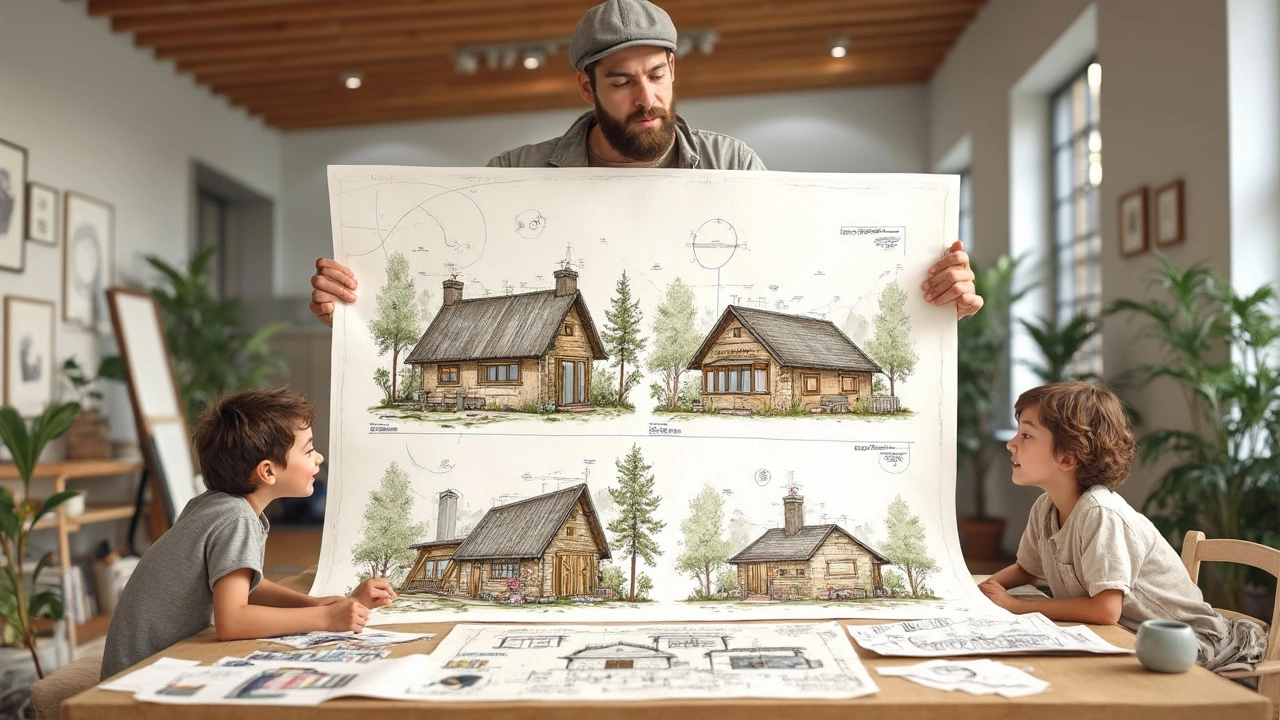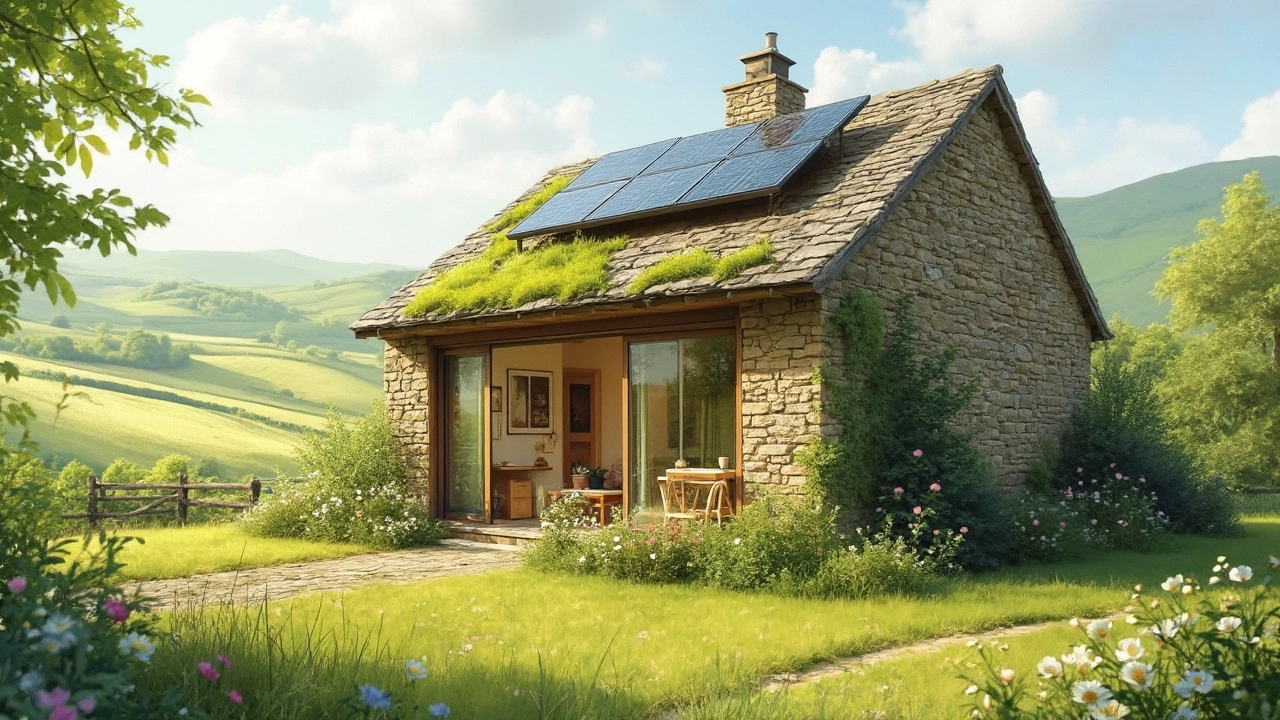What if the secret to saving thousands on your next eco-friendly cottage is as simple as the shape you choose? Seems wild, but it’s true—nailing the right house shape means less money spent on walls, roofing, and even your power bill.
This isn’t just about looks. It’s real math: more corners, weird angles, and twists mean more materials and labor. The simplest shapes cut waste and slash those annoying extra costs. Plus, some designs make it way easier to keep warm in the winter and cool in the summer, which trims your future bills like a pro.
If you’ve ever stared at blueprints and wondered whether that funky design is worth it, or if going basic would hurt your eco-goals—good news: you can keep things simple and still stay green. The trick? Understand how different shapes affect your wallet, your planet, and your comfort.
- Why Shape Matters for Cost
- Comparing Popular Cottage Shapes
- The Surprising Winner: The Cube and Dome Debate
- Practical Tips to Maximize Savings
Why Shape Matters for Cost
Shape isn’t just about curb appeal—it's a big deal when it comes to your budget and your eco goals. The economical house shape you pick can make your build way cheaper or way more expensive. Simple forms, like a square or cube, use fewer materials and take less time to put together. Every extra wall, corner, or angle adds up, and not in your favor.
Think about this: The more outside surface your cottage has (called the building's envelope), the more spots for heat to escape during winter and sneak in during summer. That means higher energy bills for heating and cooling. The basic rule? The more compact the shape, the smarter you’re being with both money and energy.
Builders talk about something called the "surface area to volume ratio." It's just a nerdy way to say: how much wall and roof does your place need to wrap around your living space? A sphere has the lowest ratio, but unless you’re living in a ball, a cube or rectangle is your go-to for being practical and cheap.
Check out this quick comparison of how shape affects these costs:
| House Shape | Surface Area (sq ft) per 1,000 sq ft interior | Estimated Material Cost |
|---|---|---|
| Cube | 600 | Lowest |
| L-shaped | 730 | Medium |
| Complex (e.g. with bump-outs) | 800+ | Highest |
Choosing a sustainable design also gets easier when you keep shapes simple. Square or rectangular floor plans waste less building material—think fewer offcuts and scraps lying around at the end of your build. Plus, the labor is simpler and less error-prone, and you’re less likely to run into weird, expensive surprises halfway through construction.
Bottom line: Picking the right shape for your eco-friendly cottage is a quick win for your wallet and the planet. Fewer surfaces, tighter designs, less heat loss, and less stuff to buy—what’s not to like?
Comparing Popular Cottage Shapes
If you want to build an economical house shape for your next eco-friendly cottage, you’ve probably seen a lot of funky designs online. Let’s get real about what’s actually out there, what it costs, and why some shapes just make more sense than others for saving money and energy.
The most common cottage shapes are:
- Rectangular (including boxes or simple rectangles)
- Squares (think of a cube house)
- L-shaped
- Dome (rounded houses)
- Octagonal or hexagonal
The rectangular shape is classic and usually the easiest to build. Fewer complicated angles mean less time and money spent on labor. Material waste is super low because standard lumber sizes fit right in. But a simple box shape can leak more heat if not designed well.
Square or cube-shaped cottages work a lot like rectangles but usually have a better ratio of floor space to outside wall surface—so there’s less wall for heat to escape. You use fewer materials per square foot of living space, which often makes it a winner for both energy efficiency and cost.
L-shaped layouts can be nice if you want to separate spaces inside, but extra corners and roof angles add complexity. That means more to build and more to maintain. Not ideal if you want the most bang for your buck.
Dome-shaped cottages are getting popular—and with good reason. A dome's curved surface means air flows better, and there’s less surface area for heat to escape. Studies show geodesic domes need about 25% less building materials to enclose the same space as a box. They’re also super sturdy. The catch? Domes can make interior layout and furniture placement tricky, and most builders charge more for domes because they’re not as common.
Octagonal or hexagonal shapes look cool and can boost your “wow” factor, but they make construction trickier. Each extra angle means more effort and usually more wasted materials, which isn't great for your sustainable design goals or your budget.
| Shape | Material Use (per sq ft) | Labor Complexity | Energy Efficiency |
|---|---|---|---|
| Rectangle/Square | Low | Easy | Good |
| Dome | Very Low | Medium | Excellent |
| L-Shape | Moderate | Medium | Fair |
| Octagonal/Hexagonal | High | Hard | Good |
If you want to keep things simple, stick with rectangular, square, or dome designs for your eco-friendly cottage. These shapes will make your build faster, cheaper, and way easier to keep warm or cool.

The Surprising Winner: The Cube and Dome Debate
If you ask architects or anyone deep into eco-friendly cottage design, there are two shapes that always stir up debate: the classic cube and the quirky dome. Both have fans, and both can save you serious money—but they do it in different ways.
The cube is pretty much the MVP of economical house shape. Here’s why: a cube keeps the surface area—the outside parts you have to insulate and cover—to a minimum compared to how much space you get inside. Less surface area means you pay less for building materials, and you lose less heat through the walls and roof. That slashes your energy costs, especially in those chilly months. For builders, squares and rectangles are easy—less cutting, less waste, and getting your permits approved is usually simpler.
But then there’s the dome. These are like the eco-geek’s dream, and for good reason. A dome shape actually offers the best surface-to-volume ratio, so you end up with the fewest exterior bits for the indoor space. Plus, wind just rolls right off domes, which is super handy if you live somewhere stormy. Some real stats: The American Institute of Architects once pointed out that dome homes can use up to 50% less energy for heating and cooling.
| Shape | Material Efficiency | Energy Efficiency | Construction Cost |
|---|---|---|---|
| Cube | Excellent | Very Good | Low |
| Dome | Outstanding | Best | Varies* |
*Domes can be cheaper to heat but more expensive to build at first, mostly because not every builder knows how to put one together. You may need custom windows or special roofing, which can bump up initial costs.
If you’re still on the fence, here’s the cool part: for most DIY or budget-focused eco-friendly cottages, cubes are usually the favorite because every contractor knows how to build them. Domes are awesome for saving energy, but only if you’re cool with finding a builder who’s done one before and maybe shelling out a little more at the start.
Bottom line? Both shapes can make your home greener and cheaper to run, but the cube usually wins for total cost and ease. The dome is unbeatable if you’re chasing the lowest possible energy bill and don’t mind the upfront work.
Practical Tips to Maximize Savings
Ready to build an economical house shape for your eco-friendly cottage? Here’s how to get the most bang for your buck from blueprint to finish. These tips don’t just save cash—they help keep your house truly green.
- Stick to simple shapes. The cube or rectangular box always wins on cost. Fewer corners mean less material waste and way faster construction. That means you’ll pay less for both supplies and labor.
- Go for compact designs. A smaller footprint is easier to insulate and uses less wall area per square foot of space. This equals lower heating and cooling bills over time—and that stuff adds up.
- Think about roof design. Simple gable or flat roofs are cheaper to build and maintain than complicated angles or fancy curves. Plus, straightforward roofs make it easier to add solar panels later, which just keeps saving you money.
- Maximize south-facing windows (if you’re in the Northern Hemisphere). You’ll snag free sunlight for warmth in winter but avoid overheating in summer with the right overhangs. Good orientation makes a surprisingly big difference—passive solar design can cut heating costs by 20% or more.
- Don’t skip insulation. Cutting corners here just leads to regret (and bigger bills). The extra up-front spend pays for itself. Energy-efficient cottages with high insulation often cut energy use by up to half, compared to minimum-code homes.
If you’re curious about the numbers, here’s a quick side-by-side of estimated wall material costs for popular cottage shapes, assuming you’re after about 1,000 square feet of living space:
| House Shape | Wall Length (ft)* | Cost Estimate ($)† |
|---|---|---|
| Perfect Cube | 126 | ~8,000 |
| Rectangular Box | 132 | ~8,400 |
| L-Shaped | 150 | ~9,600 |
| Dome | ~110 (less wall, more roof) | ~8,500 (materials only) |
*Based on exterior wall perimeter
†Very rough estimates for framing materials only, not including roof, windows, or labor
One last thing: DIY whenever you can. Even if you’re hiring pros for the heavy lifting, pitching in with painting, insulation, or landscaping can save you thousands. Just be real about your skills—fixing mistakes usually costs more than getting it right the first time.
